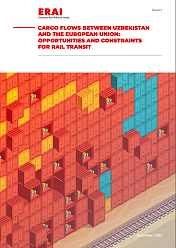Becoming the sustainable logistics backbone for European economy remains the core value and vision statement for RailCargoGroup (RCG). However, when referring to the ‘logistics backbone’, Först does not limit his aspirations only within the company he runs. Instead, he envisions a robust European rail freight that will deliver its objectives and reach further ones.
Balancing on a tightrope
The Covid-19 pandemic has undoubtedly benefited rail freight in many ways. Apart from moving a considerable share of cargo on tracks due to other transport modes’ inability to operate, the crisis has also proved that rail can be reliable and efficient enough to attract the shipper’s attention.
Of course, rail operators also had to deal with a pile of issues during this unprecedented period. The unpredictability of trip planning, travelling restrictions because of regional lockdowns and congested border-crossings because of the immense freight traffic were among their main struggles. As time passed, though, the rail sector started realising that this crisis would not last forever. Consequently, finding the fine line between this «short-term survival mode of the crisis and still putting enough resources towards the more important mid and long-term projects» turned out to be critical.
This ‘balance’ is what Först identifies as the most challenging task for him and RCG currently. According to him, rail operators should not get consumed only in resolving temporary problems. In contrast, they should also focus and invest in the future since the day that the pandemic will be over is not far away. It is then that the rail sector will have to prove that it is present and ready to undertake the task of transporting large cargo volumes.
2021 is the year of change
Another beneficial development of the pandemic is that it showed «rail’s systematic relevance during the crisis», said Först. Together with climate change, this could become an extra argument in the rail agenda. Following the crisis, 2021 could indeed become «the year of renaissance for rail, since now the sector has all the puzzle pieces in place to make change happen», he added.
Specifically, we see a firm policy conviction both on a European and national level to support the further development of rail and enjoy the environmental benefits it offers. Most importantly, though, the rail sector sees the trust of customers and shippers restored. On top of that, shippers start realising the value of sustainable transport more than ever before. «The emissions topic has fundamentally changed. We are not yet at a point where shippers are willing to pay a premium price for green transport, but they are seriously considering it in the same way they consider tolerating multimodal transport’s complexity», commented Först.
Three pillars of success
When the discussion comes to the 2030 objectives of rail reaching 30 per cent of the transport market share, Först firmly believes that the sector will succeed in this endeavour. «All rail parties work hard towards this directions», he says. This 30 per cent goal is a number rail transport already experiences in Austria, while the rail share is even bigger in Switzerland. Consequently, setting and achieving such goals is not unrealistic at all.
Nevertheless, Först set a fundamental question concerning the correct way to achieve this objective. As a result, he identified three pillars that can lead rail to success: the first relates to the need for railway undertakings to do their homework. That being said, RU’s need to adjust to diverse conditions, learn from their mistakes and utilise feedback and customer experience to their benefit.
The second pillar relates to high-performing infrastructure. European rail infrastructure is exceptionally complex and segmented, and infrastructure managers from different countries will have to sit together and create a modernised and easy to navigate railway network, allowing rail freight to reach its maximum efficiency levels. Finally, the rail sector will need assurances of fair economic and competition conditions against road haulage. Creating a level playing field for rail freight is critical in terms of growth. After all, it is not only about rail, but for the greater purpose of sustainable and emission-free transport that will transform Europe.





